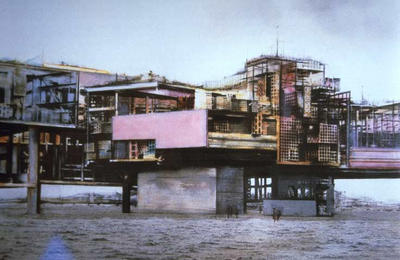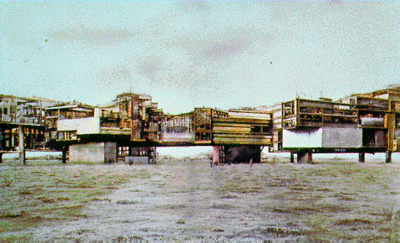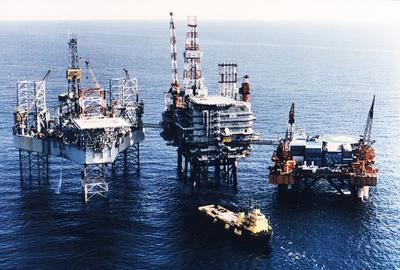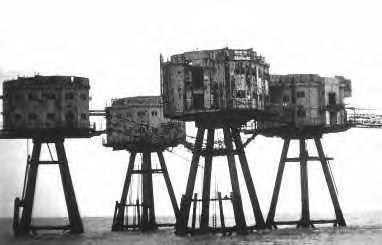Katrina 3: Two Anti-Hurricane Projects (on landscape climatology)
Project 1: "How do you slow down a hurricane?"
In the June 2005 edition of The Economist Technology Quarterly (subscription required), we read about Moshe Alamaro, "a scientist at the Massachusetts Institute of Technology, [who] has a plan. Just as setting small, controlled fires can stop forest fires by robbing them of fuel, he proposes the creation of small, man-made tropical cyclones to cool the ocean and rob big, natural hurricanes of their source of energy. His scheme, devised with German and Russian weather scientists and presented at a weather-modification conference in April, involves a chain of offshore barges adorned with upward-facing jet engines."

"Each barge creates an updraft, causing water to evaporate from the ocean's surface and reducing its temperature. The resulting tropical storms travel towards the shore but dissipate harmlessly. Dr Alamaro reckons that protecting Central America and the southern United States from hurricanes would cost less than $1 billion a year. Most of the cost would be fuel: large jet engines, he observes, are abundant in the graveyards of American and Soviet long-range bombers."
The creation of manmade tropical micro-storms, using heavy, greenhouse gas-burning jet engines towed through the waters of the equatorial Atlantic on what are, for all intents, artificial islands... is really a pretty ridiculous idea.
Yet it reminds me of a long-standing BLDGBLOG project that has otherwise gone unpublished. Till now:
Project 2: The Aeolian Reef
In Virgil's *Aeneid*, translated by Robert Fitzgerald, we read about "Aeolia, the weather-breeding isle":
"Here in a vast cavern King Aeolus
Rules the contending winds and moaning gales
As warden of their prison. Round the walls
They chafe and bluster underground. The din
Makes a great mountain murmur overhead.
High on a citadel enthroned,
Scepter in hand, he molifies their fury,
Else they might flay the sea and sweep away
Land masses and deep sky through empty air.
In fear of this, Jupiter hid them away
In caverns of black night. He set above them
Granite of high mountains – and a king
Empowered at command to rein them in
Or let them go." (Book 1, Lines 75-89)
Thus: BLDGBLOG's Aeolian Reef.
To be fair, this all began as nothing more than an idea for a new, artificial island that would be added to the Cyclades archipelago in Greece. It would be somewhere between Constant's Babylonic mid-sea pavilion –


– an oil derrick –

– the Maunsell Towers –

– and a kind of massive, off-shore, geotechnical saxophone.
Full of vaulted tubes and curved ampitheaters – and complex twists through a hollow, polished core – this modern Aeolia, an artificial island, would produce storms (and even, possibly, negate them).
A modern Aeolia, in other words, would be a "weather-breeding isle" – or a "weather-cancelling isle," as the case may be: because then there was Katrina.
What would happen, I thought, if you built a manmade, weather-cancelling isle that could *stop hurricanes from forming*? I realized, of course, immediately, that you would actually need hundreds of these tuba-like, anti-hurricane islands – even an entire manmade archipelago of them – because the atmospheric paths of storms are far too unpredictable.
You would need, that is, an Aeolian Reef.
The Aeolian Reef – and the current author, who cannot draw, hint-hint, would *love* to collaborate with any BLDGBLOG readers who want to illustrate some of these things – would consist of oil derrick-like platform-islands built in climatologically influential patterns throughout both the Gulf of Mexico and the larger, equatorial Atlantic.
The Aeolian Reef would: 1) trap and redirect high-speed winds from any burgeoning tropical storms and hurricanes, thus preventing them from actually forming; 2) provide incredibly exciting meteorological/atmospheric observation platforms far out at sea; and 3) be readily exportable to other countries and other climates, for other purposes – land-based anti-tornado clusters, for instance.
This would therefore take the subject of an earlier BLDGBLOG post a few steps further: it would use architecture, or landscape architecture, as a way to directly influence, change, or redirect the climate.
It would, in short, be *landscape climatology*.
One could imagine alternative uses, of course; even a computer glitch or global supervillain who rearranges all the internal valves of the Aeolian Reef to generate the mother of all hurricanes... in which case the Reef would be something of a national security threat. But how to weaponize a landscape is already discussed at the end of a previous post.
This thread continues in Katrina 1: Levee City (on military hydrology); and Katrina 2: New Atlantis (on flooded cities) – both on BLDGBLOG.
In the June 2005 edition of The Economist Technology Quarterly (subscription required), we read about Moshe Alamaro, "a scientist at the Massachusetts Institute of Technology, [who] has a plan. Just as setting small, controlled fires can stop forest fires by robbing them of fuel, he proposes the creation of small, man-made tropical cyclones to cool the ocean and rob big, natural hurricanes of their source of energy. His scheme, devised with German and Russian weather scientists and presented at a weather-modification conference in April, involves a chain of offshore barges adorned with upward-facing jet engines."

"Each barge creates an updraft, causing water to evaporate from the ocean's surface and reducing its temperature. The resulting tropical storms travel towards the shore but dissipate harmlessly. Dr Alamaro reckons that protecting Central America and the southern United States from hurricanes would cost less than $1 billion a year. Most of the cost would be fuel: large jet engines, he observes, are abundant in the graveyards of American and Soviet long-range bombers."
The creation of manmade tropical micro-storms, using heavy, greenhouse gas-burning jet engines towed through the waters of the equatorial Atlantic on what are, for all intents, artificial islands... is really a pretty ridiculous idea.
Yet it reminds me of a long-standing BLDGBLOG project that has otherwise gone unpublished. Till now:
Project 2: The Aeolian Reef
In Virgil's *Aeneid*, translated by Robert Fitzgerald, we read about "Aeolia, the weather-breeding isle":
"Here in a vast cavern King Aeolus
Rules the contending winds and moaning gales
As warden of their prison. Round the walls
They chafe and bluster underground. The din
Makes a great mountain murmur overhead.
High on a citadel enthroned,
Scepter in hand, he molifies their fury,
Else they might flay the sea and sweep away
Land masses and deep sky through empty air.
In fear of this, Jupiter hid them away
In caverns of black night. He set above them
Granite of high mountains – and a king
Empowered at command to rein them in
Or let them go." (Book 1, Lines 75-89)
Thus: BLDGBLOG's Aeolian Reef.
To be fair, this all began as nothing more than an idea for a new, artificial island that would be added to the Cyclades archipelago in Greece. It would be somewhere between Constant's Babylonic mid-sea pavilion –


– an oil derrick –

– the Maunsell Towers –

– and a kind of massive, off-shore, geotechnical saxophone.
Full of vaulted tubes and curved ampitheaters – and complex twists through a hollow, polished core – this modern Aeolia, an artificial island, would produce storms (and even, possibly, negate them).
A modern Aeolia, in other words, would be a "weather-breeding isle" – or a "weather-cancelling isle," as the case may be: because then there was Katrina.
What would happen, I thought, if you built a manmade, weather-cancelling isle that could *stop hurricanes from forming*? I realized, of course, immediately, that you would actually need hundreds of these tuba-like, anti-hurricane islands – even an entire manmade archipelago of them – because the atmospheric paths of storms are far too unpredictable.
You would need, that is, an Aeolian Reef.
The Aeolian Reef – and the current author, who cannot draw, hint-hint, would *love* to collaborate with any BLDGBLOG readers who want to illustrate some of these things – would consist of oil derrick-like platform-islands built in climatologically influential patterns throughout both the Gulf of Mexico and the larger, equatorial Atlantic.
The Aeolian Reef would: 1) trap and redirect high-speed winds from any burgeoning tropical storms and hurricanes, thus preventing them from actually forming; 2) provide incredibly exciting meteorological/atmospheric observation platforms far out at sea; and 3) be readily exportable to other countries and other climates, for other purposes – land-based anti-tornado clusters, for instance.
This would therefore take the subject of an earlier BLDGBLOG post a few steps further: it would use architecture, or landscape architecture, as a way to directly influence, change, or redirect the climate.
It would, in short, be *landscape climatology*.
One could imagine alternative uses, of course; even a computer glitch or global supervillain who rearranges all the internal valves of the Aeolian Reef to generate the mother of all hurricanes... in which case the Reef would be something of a national security threat. But how to weaponize a landscape is already discussed at the end of a previous post.
This thread continues in Katrina 1: Levee City (on military hydrology); and Katrina 2: New Atlantis (on flooded cities) – both on BLDGBLOG.





Comments are moderated.
If it's not spam, it will appear here shortly!
Show me the money and I'll show you some reefs... Meanwhile the coral reefs of Ireland are disappearing – expect tsunamis soon, I suppose.
And, further afield, a hurricane (aka a typhoon) just hit China.
landscape has always affected climate, the Guardian: in Siberia 'an area of permafrost spanning a million square kilometres - the size of France and Germany combined - has started to melt for the first time since it formed 11,000 years ago at the end of the last ice age.' melting landscape-->tonnes of methane released-->global climate change, 'landscape climatology'
Another new anti-hurricane technology is a method for the reduction of tropical cyclones’ destructive force - pumping sea water and diffused in the wind at the bottom of such tropical cyclone in its eyewall.
Antihurricane technology fund -
www.ahtfund.org
A method of and a facility for the reduction of tropical cyclones’ destructive force.
The invention relates to a method of suppressing the tropical cyclones’ destructive force characterised in that the ascendant speed of wind in a tropical cyclone’s eyewall is reduced by sea water pumped on-site from under the sea surface above the sea surface and diffused in the wind at the bottom of such tropical cyclone in/near its eyewall. The invention also describes a facility for the application of said method.
Style and equipment on reduction destructive forces tropical cyclone
patent touch style cover destructive forces tropical cyclone resident therein, that on cut-down upwardly wind velocity in the wall eye tropical cyclone he applies sea-water evacuation in colanders from under surface up surface wainscot (a few 10m) scattering in breather at the bottom of tropical cyclone in/near wall eye, that is of drifting skywards 8-12 km.
Component patent it is also equipment on performance hereof style, whose equals function:
* transport in/toward wall eye tropical cyclone
* stay in/near wall eye cyclone near coming along cyclone
* wab sea water spopod surface and disperse her in ascending flow tropical cyclone.
Example damping output one's machinery near evacuation 300 m3 waters behind 1 second and drifting in average treble 10 km is then P = @.V.g.h.t-1 = 1000.300.10.10000.1 W = 30 000 000 000 W, id est 30 000 MW. By using e.g . 4 horsepower per cylinder equal furnished is output quadruple, so 120 000 MW (120 GW), by using 4 furnished for the duration of 4 days is performance 11 520 GWh = 11,5 TWh.
Descriptors: anti hurricane, antihurricane, technology, anti typhoon, antityphoone, anti cyclone, anticyclone, destroy the hurricanes, kill the hurricanes, destruct, paralyse, defuse reduce, slack
(WO/2006/085830) A METHOD OF AND A DEVICE FOR THE REDUCTION OF TROPICAL CYCLONES DESTRUCTIVE FORCE
Antihurricane technology Fund
video - new_anti-hurricane_technology_wheel.wmv - downloads
Hurricanes active technology prevention
Anti-hurricane technology Fund - Actively, straight muffle hurricane, rise him straight in roads, find his depression, utilize his strength straight against him very, let he destroys alone.
Post a Comment